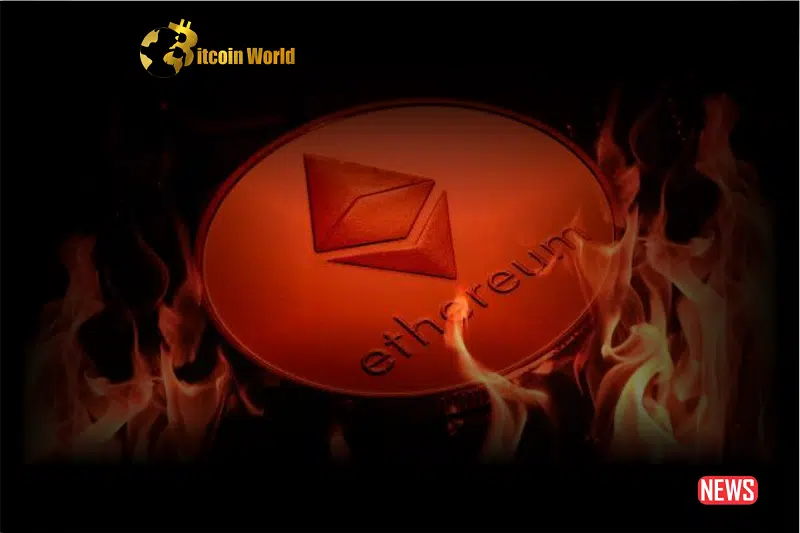Imagine a currency that not only holds its value but actively increases it over time due to a shrinking supply. That’s the vision behind Ethereum’s quest to become “ultra sound money.” Since the monumental shift known as “The Merge,” Ethereum has been on a fascinating journey, transforming from a proof-of-work system to a more sustainable proof-of-stake model. But what does this mean for you, the crypto enthusiast, and what exactly is this “ultra sound money” concept?
The Merge: A Game Changer for Ethereum’s Economics
Two years ago, on September 14, 2021, Ethereum took a giant leap forward by merging its existing execution layer with the Beacon Chain. This marked the end of proof-of-work and the dawn of proof-of-stake. This transition wasn’t just a technological upgrade; it had profound economic implications. One of the most significant outcomes? The introduction of a mechanism that burns ETH, effectively reducing its total supply.
How Much ETH Has Been Burned?
The numbers are quite striking. According to Ultra Sound Money data, as of August 7th, over 3.5 million ETH has been burned out of the 6.5 million ETH issued since The Merge. Let’s break that down:
- ETH Issued Since The Merge: Approximately 6.5 million ETH
- ETH Burned Since The Merge: Over 3.5 million ETH
This active burning has led to a fascinating phenomenon: Ethereum is now experiencing slight deflation. But what does deflation mean in the context of cryptocurrency?
Ethereum: Becoming a Deflationary Asset
In simple terms, deflation means the supply of an asset is decreasing. For Ethereum, this translates to roughly a 0.98% annual decrease in its supply. Think of it like this: with fewer ETH available over time, the remaining ETH could potentially become more valuable, assuming demand stays constant or increases.
The Numbers Behind the Deflation
Here’s a snapshot of Ethereum’s supply dynamics as of August 7th:
| Metric | Value |
|---|---|
| Total Supply | Over 120.2 million ETH |
| Annual Issuance | Around 580,000 ETH |
| Annual Burn Rate | Currently outpacing a significant portion of issuance |
The ultimate goal for Ethereum enthusiasts is for the burn rate to consistently surpass the issuance rate, making Ethereum a fully deflationary asset – the coveted “ultra sound money.”
The Journey to “Ultra Sound Money”: Key Milestones
The path to this deflationary state wasn’t an overnight success. Let’s look at some crucial moments:
- September 14, 2021: The Merge. This was the pivotal moment, shifting Ethereum to a proof-of-stake consensus mechanism and laying the groundwork for deflationary economics. This also coincided with a bullish market, pushing ETH to its all-time high.
- August 2021: The London Hard Fork and EIP-1559. This upgrade was a game-changer, introducing a base fee for transactions that gets burned, rather than going to miners. This is the primary driver of Ethereum’s burning mechanism.
Where Does All This Burning Come From?
You might be wondering, what activities on the Ethereum network contribute to this significant burning of ETH? The primary sources are:
- ETH Transfers: Simple transactions of ETH from one wallet to another contribute to the base fee that gets burned.
- Smart Contract Activities: Interactions with decentralized applications (dApps) and smart contracts generate transaction fees, a portion of which is burned.
- DeFi Platforms: Popular decentralized finance (DeFi) platforms like Uniswap contribute significantly through transaction fees.
- NFT Marketplaces: Platforms like OpenSea, where users buy, sell, and trade non-fungible tokens (NFTs), also drive burning activity.
- Stablecoin Transfers: The movement of ERC-20 USDT, a popular stablecoin, also contributes to the burn.
EIP-1559: The Engine Behind the Burn
Let’s delve a bit deeper into EIP-1559. This Ethereum Improvement Proposal, activated during the London hard fork, fundamentally changed how transaction fees work. Instead of a bidding system where users competed to offer the highest gas price, EIP-1559 introduced a base fee that is algorithmically determined based on network congestion. This base fee is then burned, permanently removing ETH from circulation.
Benefits of EIP-1559:
- More Predictable Transaction Fees: While gas fees can still fluctuate, EIP-1559 aimed to make them more predictable for users.
- Improved Transaction Flow: By setting a base fee, the likelihood of transactions being included in the next block increased.
- The Burn Mechanism: This is the key takeaway. EIP-1559 is the engine driving Ethereum’s deflationary trend.
The Ongoing Challenge: Gas Fees
While EIP-1559 brought improvements, it’s important to acknowledge that gas fees on the Ethereum network remain a point of concern. They can still be quite high, especially during periods of network congestion. This is an area of ongoing development and innovation within the Ethereum ecosystem, with layer-2 scaling solutions aiming to address this challenge.
What Does the Future Hold for Ethereum as “Ultra Sound Money”?
The journey is far from over, but the progress is undeniable. As Ethereum continues to burn more ETH, the vision of “ultra sound money” becomes increasingly tangible. A fully deflationary Ethereum could have significant implications:
Potential Benefits:
- Store of Value: A decreasing supply could enhance Ethereum’s appeal as a store of value, potentially rivaling assets like Bitcoin.
- Increased Scarcity: Reduced supply inherently creates scarcity, which can drive up the price if demand remains strong.
- Economic Stability: Predictable monetary policy through the burning mechanism could contribute to greater economic stability within the Ethereum ecosystem.
Things to Consider:
- Network Activity: The burn rate is directly tied to network activity. Lower activity could slow down the deflationary process.
- Future Upgrades: Future Ethereum upgrades could introduce changes that impact the burning mechanism.
- Market Dynamics: Ultimately, the price of ETH is determined by supply and demand forces in the broader cryptocurrency market.
Conclusion: Watching Ethereum’s Deflationary Evolution
Ethereum’s transition to proof-of-stake and the implementation of EIP-1559 have set it on a compelling path towards becoming “ultra sound money.” The burning of millions of ETH is a testament to the power of this new economic model. While challenges like gas fees persist, the progress made is significant. As the crypto landscape continues to evolve, all eyes will be on Ethereum, eagerly anticipating the day it truly achieves its ambitious goal of deflationary excellence and solidifies its position as a cornerstone of the decentralized financial future.
Disclaimer: The information provided is not trading advice, Bitcoinworld.co.in holds no liability for any investments made based on the information provided on this page. We strongly recommend independent research and/or consultation with a qualified professional before making any investment decisions.


